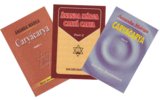Birthday Ceremony: Difference between revisions
Jump to navigation
Jump to search
(→Chapter synopsis: +++) |
(→Chapter synopsis: ++) |
||
| Line 2: | Line 2: | ||
== Chapter synopsis == | == Chapter synopsis == | ||
Sarkar told, | Sarkar told, at the beginning of the celebration all people present should do collective Iishvara Prańidhána. Then the birthday person will receive blessings and the ''tilaka'' mark (sandal paste, kumkum, etc.) from elderly people; and accept salutations, garlands and sandal paste from his juniors. Then he will accept presents and food. Usage of incense, candles, blowing of conch shells, etc., are optional. | ||
== References == | == References == | ||
Revision as of 00:54, 13 March 2014
Birthday Ceremony is the 20th chapter of Ananda Marga Caryacarya Part 1 written by Prabhat Ranjan Sarkar. In this chapter Sarkar instructed the procedure of celebrating birthday ceremony.[1]
Chapter synopsis
Sarkar told, at the beginning of the celebration all people present should do collective Iishvara Prańidhána. Then the birthday person will receive blessings and the tilaka mark (sandal paste, kumkum, etc.) from elderly people; and accept salutations, garlands and sandal paste from his juniors. Then he will accept presents and food. Usage of incense, candles, blowing of conch shells, etc., are optional.
References
- ^ Prabhat Ranjan Sarkar "Birthday Ceremony" The Electronic Edition of the Works of P. R. Sarkar (in English) (7.5 ed.) Ananda Marga Pracaraka Samgha
| Preceded by |
Ananda Marga Caryacarya Part 1 With: Birthday Ceremony |
Succeeded by |
